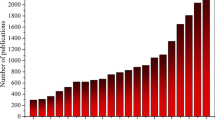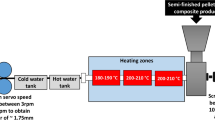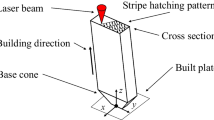Abstract
Graded porous structures, combining the high stiffness of bulk designs and the robustness of porous structures, have received increasing attention in the fields of topology optimization and additive manufacturing. This study aims to experimentally investigate the properties of topology-optimized and additively manufactured graded porous structures, with comparisons to conventional bulk designs and one-level porous structures. Examples with graded porosity are designed through a unique multiporosity topology optimization framework. This multiporosity framework generalizes the concept of multiple materials; i.e., each material field has a different level of local porosity, thus realizing the automatic distribution of multilevel porosity. The optimized designs are fabricated via the mask stereolithography process using photosensitive resins. Based on three-point bending tests, we study the failure processes and the influences of material deficiency on elastic stiffness for the three types of optimized designs: bulk, one-level porous, and graded porous designs. Experimental results demonstrate that the additively manufactured optimized graded porous structures not only have relatively high structural stiffness and load-carrying capacities but also show a ductile failure mode and certain robustness against material deficiency. The presented work contributes to experimental studies on demonstrating the combined advantages of topology-optimized graded porous structures by comparing the structural performances of graded porous structures with bulk designs and one-level porous structures.







Similar content being viewed by others
References
W. Jun, N. Aage, R. Westermann, and O. Sigmund, IEEE Trans. Vis. Comput. Graph. 24, 1127 (2017)
M.-P. Schmidt, C.B.W. Pedersen, and C. Gout, Struct. Multidiscip. Optim. 60, 1437 (2019)
F. Wang, and O. Sigmund, Struct. Multidiscip. Optim. 61, 2629 (2020)
S. Das, and A. Sutradhar, Mater. Des. 193, 108775 (2020)
J.P. Groen, W. Jun, and O. Sigmund, Comput. Methods Appl. Mech. Eng. 349, 722 (2019)
D. Xue, Y. Zhu, and X. Guo, Comput. Methods Appl. Mech. Eng. 366, 113037 (2020)
H. Zhang, Y. Wang, and Z. Kang, Int. J. Eng. Sci. 138, 26 (2019)
W. Zijun, L. Xia, S. Wang, and T. Shi, Comput. Methods Appl. Mech. Eng. 345, 602 (2019)
C. Liu, D. Zongliang, Y. Zhu, W. Zhang, X. Zhang, and X. Guo, Comput. Methods Appl. Mech. Eng. 369, 113187 (2020)
A. Clausen, N. Aage, and O. Sigmund, Engineering 2, 250 (2016)
L. Cheng, J. Bai, and A.C. To, Comput. Methods Appl. Mech. Eng. 344, 334 (2019)
Z. Zhao, and X.S. Zhang, Struct. Multidiscip. Optim. (2021). https://doi.org/10.1007/s00158-021-02870-x
O. Sigmund, Struct. Multidiscip. Optim. 33, 401 (2007)
F. Wang, B.S. Lazarov, and O. Sigmund, Struct. Multidiscip. Optim. 43, 767 (2011)
T. Gao, W. Zhang, and P. Duysinx, Int. J. Numer. Meth. Eng. 91, 98 (2012)
X.S. Zhang, and H. Chi, Mech. Res. Commun. 105, 103494 (2020)
M. Jansen, G. Lombaert, M. Schevenels, and O. Sigmund, Struct. Multidiscip. Optim. 49, 657 (2014)
T. Zegard, and G.H. Paulino, Struct. Multidiscip. Optim. 53, 175 (2016)
V.S.D. Voet, T. Strating, G.H.M. Schnelting, P. Dijkstra, M. Tietema, X. Jin, A.J.J. Woortman, K. Loos, J. Jager, and R. Folkersma, ACS Omega 3, 1403 (2018)
Y.-C. Chan, K. Shintani, and W. Chen, Front. Mech. Eng. 14, 141 (2019)
W. Li, and X.S. Zhang, Int. J. Numer. Methods Eng. (2021). https://doi.org/10.1002/nme.6672
M. Schevenels, B.S. Lazarov, and O. Sigmund, Comput. Methods Appl. Mech. Eng. 200, 3613 (2011)
Acknowledgements
The authors acknowledge financial support from the National Center for Supercomputing Applications (NCSA) at the University of Illinois at Urbana-Champaign. The information provided in this paper is the sole opinion of the authors and does not necessarily reflect the view of the sponsoring agencies.
Author information
Authors and Affiliations
Corresponding author
Ethics declarations
Conflict of Interest
On behalf of all authors, the corresponding author states that there are no conflicts of interest.
Replication of Results
Data are available from authors upon request.
Additional information
Publisher’s Note
Springer Nature remains neutral with regard to jurisdictional claims in published maps and institutional affiliations.
Rights and permissions
About this article
Cite this article
Zhao, Z., Zhang, X.S. Additive Manufacturing of Topology-Optimized Graded Porous Structures: An Experimental Study. JOM 73, 2022–2030 (2021). https://doi.org/10.1007/s11837-021-04705-y
Received:
Accepted:
Published:
Issue Date:
DOI: https://doi.org/10.1007/s11837-021-04705-y




